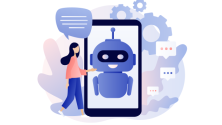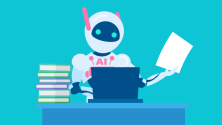Having recently re-watched the “Iron Man” movie franchise, I was fascinated again with J.A.R.V.I.S., Tony Stark’s artificially intelligent computer. Imagine the vast amounts of information J.A.R.V.I.S. needs access to in order to fulfill a request or anticipate a need!
What if this artificial intelligence technology was deployed within the enterprise today? Many organizations have indeed begun to deploy AI-enabling technologies as part of their digital transformation initiatives, with information capture and process automation being the key drivers.
However, the AI hype has CIOs thinking beyond mere process efficiency. What if you could transform customer-provided content, documents, and communication into actionable context, relevance, relationships, and data? Think about how much smarter and more effective your “robots” and “robotic processes” would be if they had more information in order to make effective decisions that improve outcomes, customer service, and decisions.
[ What IT jobs will be hot in the AI age? See our related article, 8 emerging AI jobs for IT pros. ]
Robotic process automation (RPA) is a catalyst for AI and is fueled by data ingested by intelligent capture and machine-learning technology. Organizations are ripe with data waiting for intelligence. The top areas CIOs and line-of-business leaders should prioritize for AI-enabling technology are processes that offer more personalized and faster customer experiences, processes that could be more efficient, and processes that require a swift control and understanding of vast amounts of data to make smarter decisions or meet compliance.
Onboarding
An important use case where digital transformation is uprooting old processes is onboarding, including the onboarding of new employees and customers in insurance, healthcare, and finance. For example, when opening a new bank account and applying for credit cards or mortgage loans, the applicant is asked to provide a number of documents, such as an ID, employment details, and proof of address. With the help of intelligent capture and classification, this can be done with a smartphone, and extracted data can be processed by the bank’s own systems. This saves time and money for both the bank and the applicant.
Once the customer is enrolled, other systems using machine-learning technology can track and learn from this customer’s behavior to let a company offer tailored services based on the customer's credit history, lifestyle, and health. This involves pulling publicly available information and cross-referencing it with the products and services the company can offer. An insurance company, for example, would be able to make smarter decisions knowing an applicant was involved in extreme sports by cross-referencing social sites.
Accounts payable and invoice processing
Automating invoices and applying RPA offers more intelligence to accounts payable. Not only does AI learn an accounting staff’s manual processes, but it also gives staff more control over the approval cycle. AI can also help staff make better decisions with the use of graphical dashboards that give real-time status of staff productivity, invoices, and the source of exceptions, key performance indicators, and more.
Digital workforce
Another area where AI capabilities are changing the corporate landscape is in hiring a “digital workforce” by automating repetitive tasks or processes with RPA. Says Forrester Research in its report, Predictions 2018: Automation Alters The Global Workforce: “As enterprises become more acclimated with automation, RPA will take over low-value repetitive tasks and rote work. In 2018, RPA-based digital workers (i.e., bots) will replace and/or augment 311,000 office and administrative positions and 260,000 sales and related jobs to deliver enhanced customer experiences. Digital transformation spending will increasingly emphasize automation, and operating models will be re-engineered around it.”
By automating workflows and learning from human intervention on-the-go, RPA allows knowledge workers to focus on addressing exceptions or solving problems.
Compliance and risk
Lastly, organizations should deploy AI in applications where a system can learn to understand, find, extract, and provide insights from unstructured documents, such as commercial agreements and contracts. This is a topical area in light of data protection rules where enterprises need to process vast amounts of documents to control and mitigate compliance risk.
Want more wisdom like this, IT leaders? Sign up for our weekly email newsletter.








Comments
AI definitely helps in implementing an effective digital transformation strategy, which is imperative for businesses in this digital age.